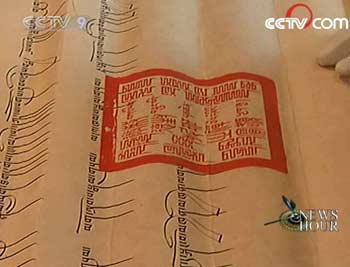China
Tibetan cultural relics in Forbidden City prove Tibet part of China
WATCH VIDEO
In the Qing Dynasty, the 5th and 13th Dalai Lama as well as the 6th Panchen Lama all had an audience with the sovereign. One of the most powerful pieces of evidence relating to this fact is the congratulatory letter written by the 6th Panchen for the 70th birthday of Emperor Qianlong. The main body of the letter was written in ink in Tibetan. But the names of the Buddha and the emperor were in a golden color. The letter was signed off with a crimson seal.
 |
| The main body of the letter was written in ink in Tibetan. But the names of the Buddha and the emperor were in a golden color. The letter was signed off with a crimson seal. |
Wang Jiapeng said, "The seal was bestowed by the imperial court of the Qing Dynasty to the 6th Panchen. The seal says "The Treasure of the Panchen Erdeni". It's written in 4 languages, Chinese, Manchurian, Mongolian and Tibetan. The letter's content is full of congratulations on Emperor Qianlong's birthday, and praise for his political achievements, as well as a catalogue of the gifts for the emperor."
Experts say these cultural relics are the best historical proof that the Han and Tibetan ethnic groups have been historically dependent on each other for their development.
Wang Jiapeng said, "Every piece of cultural relic is a chronicler of historical evolution. Tracing the origin of the rich collections of Tibetan cultural relics here enables us to see that Tibet has been a part of China since ancient times."
Experts say in history, relations between the Han and Tibetan ethnic groups as well as the ties between Tibet and the central government were at their best during the Qing Dynasty.
Editor:Zhang Ning



